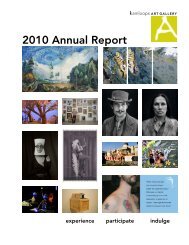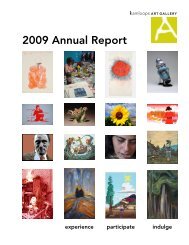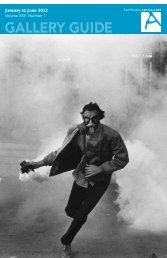to open the article, Spirit of a Nation, by Ken Favrholdt, which was ...
to open the article, Spirit of a Nation, by Ken Favrholdt, which was ...
to open the article, Spirit of a Nation, by Ken Favrholdt, which was ...
Create successful ePaper yourself
Turn your PDF publications into a flip-book with our unique Google optimized e-Paper software.
The following <strong>article</strong>, <strong>Spirit</strong> <strong>of</strong> a <strong>Nation</strong> <strong>by</strong> <strong>Ken</strong> <strong>Favrholdt</strong>, <strong>was</strong> published in <strong>the</strong> Saturday, January 13,<br />
2007 issue <strong>of</strong> The Daily News in Kamloops and has been edited for <strong>the</strong> KAG website.<br />
When most people think <strong>of</strong> 20th century<br />
Canadian painting, <strong>the</strong>y think <strong>of</strong> <strong>the</strong> work <strong>of</strong><br />
<strong>the</strong> Group <strong>of</strong> Seven and a few individuals like<br />
Emily Carr who chose <strong>to</strong> paint scenes <strong>of</strong> <strong>the</strong><br />
primeval wilderness and quaint rural<br />
settlements. These protagonists <strong>of</strong> <strong>the</strong><br />
Canadian landscape painted <strong>the</strong> country as no<br />
o<strong>the</strong>rs had done before. Their work became<br />
<strong>the</strong> “image <strong>of</strong> Canada” <strong>to</strong> people at home<br />
and abroada nation <strong>of</strong> mountains, snow and<br />
ice, rocks and forests, small villages, and old<br />
<strong>to</strong>tems. This stereotype continues <strong>to</strong> exert its<br />
influence <strong>to</strong>day, but it has competition. After<br />
World War II, ano<strong>the</strong>r image <strong>of</strong> Canada <strong>was</strong><br />
ready <strong>to</strong> be revealed and represented<strong>the</strong><br />
picture <strong>of</strong> a country that <strong>was</strong> emerging from<br />
<strong>the</strong> wilderness, throwing <strong>of</strong>f <strong>the</strong> shackles <strong>of</strong><br />
colonialism, and becoming urbanized,<br />
industrialized, and, above all, modern. To this<br />
end, painters turned <strong>the</strong>ir attention <strong>to</strong><br />
Canada’s cities.<br />
It <strong>was</strong> in <strong>the</strong> early 1950s that whisky baron<br />
Samuel Bronfman, a maverick businessman<br />
who supported <strong>the</strong> arts, commissioned a<br />
group <strong>of</strong> Canadian artists <strong>to</strong> travel across <strong>the</strong><br />
country <strong>to</strong> paint views <strong>of</strong> <strong>the</strong> cities <strong>of</strong> Canada.<br />
Their work turned in<strong>to</strong> an international and<br />
national travelling exhibition titled Cities <strong>of</strong><br />
Canada. The Kamloops Art Gallery is now<br />
hosting <strong>the</strong> best <strong>of</strong> <strong>the</strong> paintings from <strong>the</strong><br />
original show in <strong>the</strong> exhibition Cities <strong>of</strong><br />
Canada: The Seagram Collection, <strong>which</strong> brings<br />
many <strong>of</strong> <strong>the</strong>se paintings <strong>to</strong> light for <strong>the</strong> first<br />
time in half a century.<br />
It is no accident that a new interest in<br />
Canadian cities occurred in <strong>the</strong> post-war years<br />
when Canada entered a long boom period. By<br />
1951, Canada <strong>was</strong> becoming increasingly<br />
urban with 62 per cent <strong>of</strong> its population living<br />
in cities. Immigration from post-war Europe<br />
<strong>was</strong> attracting newcomers, especially<br />
pr<strong>of</strong>essionals and skilled workers, <strong>to</strong> <strong>the</strong> major<br />
Canadian cities. Not since pre-World War I<br />
had immigration been so high. Interestingly,<br />
<strong>the</strong> s<strong>to</strong>ry <strong>of</strong> <strong>the</strong> Bronfman family is one <strong>of</strong><br />
those early tales <strong>of</strong> immigration.<br />
Samuel Bronfman (1889-1971) <strong>was</strong> one <strong>of</strong><br />
eight children <strong>of</strong> Mindel and Ekiel Bronfman,<br />
Jewish refugees from Bessarabia (present<br />
Moldova) in Eastern Europe who settled in<br />
Mani<strong>to</strong>ba where <strong>the</strong>y entered <strong>the</strong> hotel<br />
business in 1903. Here, young Samuel also<br />
learned about <strong>the</strong> liquor business and in 1916,<br />
during <strong>the</strong> prohibition era, set himself up as a<br />
distribu<strong>to</strong>r. Bronfman founded <strong>the</strong> Distillers<br />
Corporation in Montreal in 1924, merged with<br />
Joseph E. Seagram & Sons <strong>of</strong> Waterloo,<br />
Ontario, in 1928, <strong>the</strong>n began <strong>to</strong> build an<br />
empire based on <strong>the</strong> appeal <strong>of</strong> brand names<br />
such as Chivas Regal, Crown Royal, and<br />
Seagram’s V.O.<br />
But Bronfman’s interest <strong>was</strong> not just making<br />
liquor. A philanthropist as well as a shrewd<br />
entrepreneur, he felt that industry should go<br />
beyond <strong>the</strong> boundaries <strong>of</strong> its fac<strong>to</strong>ries. He<br />
believed that private enterprise should take an<br />
active part in promoting culture. In 1951<br />
Samuel Bronfman commissioned 22 artists <strong>to</strong><br />
paint scenes <strong>of</strong> <strong>the</strong> cities across <strong>the</strong> country.<br />
Robert Pilot and A. Y. Jackson were his main<br />
contacts who recruited artists from <strong>the</strong> Royal<br />
Canadian Academy <strong>of</strong> Arts. Most <strong>of</strong> <strong>the</strong>m<br />
were born in eastern CanadaToron<strong>to</strong>,<br />
Ottawa, and Montreal. A few, including<br />
Charles Comfort, Joseph Hallam, and Alfred<br />
1
Creigh<strong>to</strong>n, came from <strong>the</strong> United Kingdom.<br />
Ernst Neumann <strong>was</strong> born in Hungary. The lone<br />
woman, Frances-Anne Johns<strong>to</strong>n, born in<br />
Toron<strong>to</strong>, <strong>was</strong> <strong>the</strong> daughter <strong>of</strong> Group <strong>of</strong> Seven<br />
artist Frank Johns<strong>to</strong>n.<br />
The challenge for <strong>the</strong> artists <strong>was</strong> how and<br />
what <strong>to</strong> depict <strong>of</strong> Canada’s urban centres, how<br />
<strong>to</strong> capture <strong>the</strong> essence <strong>of</strong> each city, like <strong>the</strong><br />
portrait <strong>of</strong> a person, in a realistic way.<br />
The images <strong>of</strong> <strong>the</strong> cities focus mainly on<br />
industry and commerce: Trois Rivières, <strong>the</strong><br />
Paper Capital with its many mills; Shawinigan<br />
Falls with its hydroelectricity and aluminum<br />
plant; Windsor with its au<strong>to</strong>mobile industry;<br />
Sarnia with its oil refineries; Fort William and<br />
Port Arthur’s grain port; Vancouver and its<br />
harbour; Industrial Hull with its Eddy paper<br />
mill; Toron<strong>to</strong> and its financial district; and<br />
Sudbury with its nickel and copper mines.<br />
Although a few <strong>of</strong> <strong>the</strong> paintings linger on <strong>the</strong><br />
colonial past <strong>of</strong> some cities, such as Montreal’s<br />
Place d’Armes <strong>by</strong> H.S. Palmer and Dominion<br />
Square <strong>by</strong> A.B. Cloutier, or <strong>the</strong> rural horizon<br />
seen in R. York Wilson’s Regina, city in <strong>the</strong><br />
wheatfields, <strong>the</strong> bulk are unabashed views <strong>of</strong><br />
Canada’s urban powerhouses.<br />
My favourite painting, and indeed <strong>the</strong><br />
<strong>to</strong>uchs<strong>to</strong>ne <strong>of</strong> this exhibition, is Charles<br />
Comfort’s panorama <strong>of</strong> Edmon<strong>to</strong>n, <strong>which</strong> he<br />
described as “a great booming vortex <strong>of</strong><br />
industrial enterprises.” Comfort stated: “I<br />
chose <strong>to</strong> paint a portrait <strong>of</strong> Edmon<strong>to</strong>n and not<br />
a created myth <strong>of</strong> my own about <strong>the</strong> city; no<br />
artificial symbolism could communicate…<strong>the</strong><br />
vigor and promise contained in that location.”<br />
Titled Edmon<strong>to</strong>n, skyline <strong>of</strong> <strong>the</strong> north,<br />
Comfort’s dramatic view along <strong>the</strong> North<br />
Saskatchewan River suggests <strong>the</strong> expansion<br />
and growth <strong>of</strong> Alberta’s capital as <strong>the</strong> gateway<br />
<strong>to</strong> Arctic. Indeed, Comfort has captured a<br />
mise en scène <strong>of</strong> Edmon<strong>to</strong>n abuzz with activity<br />
trains, planes, au<strong>to</strong>mobiles, and signs <strong>of</strong><br />
industry among new buildings. Smoke<br />
belching from fac<strong>to</strong>ries and train blends with<br />
clouds in <strong>the</strong> big prairie sky.<br />
Comfort <strong>was</strong> born in Edinburgh and moved <strong>to</strong><br />
Canada in 1912, settling in Winnipeg. He later<br />
studied in New York and <strong>the</strong>n moved <strong>to</strong><br />
Toron<strong>to</strong> where he served as direc<strong>to</strong>r <strong>of</strong> Mural<br />
Painting at <strong>the</strong> Ontario College <strong>of</strong> Art in <strong>the</strong><br />
late 1930s. He also taught art at <strong>the</strong> University<br />
<strong>of</strong> Toron<strong>to</strong>. During World War II, Comfort <strong>was</strong><br />
<strong>the</strong> senior war artist with <strong>the</strong> Canadian army in<br />
both <strong>the</strong> United Kingdom and Italy. From<br />
1960 <strong>to</strong> 1965 he <strong>was</strong> Direc<strong>to</strong>r <strong>of</strong> <strong>the</strong> <strong>Nation</strong>al<br />
Gallery <strong>of</strong> Canada. His style is quintessentially<br />
modernist, and he <strong>was</strong> well known as a<br />
“brilliant technician,” according <strong>to</strong> art<br />
his<strong>to</strong>rian J. Russell Harper.<br />
Bronfman’s <strong>to</strong>uring exhibition <strong>was</strong> groundbreaking.<br />
The stereotype <strong>of</strong> Canada as “a vast<br />
untamed wilderness” is superseded <strong>by</strong> a new<br />
image <strong>of</strong> a country that has matured. In<br />
Bronfman’s words, <strong>the</strong> exhibition “hopes…<strong>to</strong><br />
establish abroad a familiarity with our urban<br />
life, and thus <strong>to</strong> evoke a closer rapport<br />
between ourselves and <strong>the</strong> world.” At <strong>the</strong><br />
same time he <strong>was</strong> promoting Canada,<br />
Bronfman sought <strong>to</strong> expand his business in<br />
new markets. He bought <strong>the</strong> majority interest<br />
in many local companies in <strong>the</strong> Caribbean,<br />
South America and Europe. The exhibition<br />
<strong>to</strong>ured internationally in 1953-54 <strong>to</strong> San Juan,<br />
Havana, Mexico City, Caracas, Rio de Janeiro,<br />
Sao Paulo, Buenos Aires, Montevideo, Rome,<br />
Madrid, Paris, London, The Hague, Geneva,<br />
S<strong>to</strong>ckholm, and ending at Soest, West<br />
Germany, where <strong>the</strong> Canadian military had a<br />
base. The exhibition <strong>was</strong> shown a mere seven<br />
<strong>to</strong> 13 days at each venue, including grand<br />
2
hotels and public buildings in <strong>the</strong> various<br />
cities, but <strong>was</strong> seen <strong>by</strong> 200,000 people. The<br />
highest attendance <strong>was</strong> in S<strong>to</strong>ckholm where<br />
28,000 Swedes discovered <strong>the</strong> new Canadian<br />
art.<br />
Of <strong>the</strong> 90 works originally commissioned <strong>by</strong><br />
Bronfman, 83 pieces were donated <strong>to</strong> <strong>the</strong><br />
McCord Museum <strong>of</strong> His<strong>to</strong>ry at McGill<br />
University, Montreal, in 2000. Curated <strong>by</strong> Ihor<br />
Holubizky for <strong>the</strong> McCord Museum, <strong>the</strong><br />
present version <strong>of</strong> Cities <strong>of</strong> Canada includes<br />
39 <strong>of</strong> <strong>the</strong> original paintings, many <strong>of</strong> <strong>which</strong><br />
had not been displayed in public since 1967<br />
until <strong>the</strong> <strong>open</strong>ing <strong>of</strong> <strong>the</strong> show in Montreal in<br />
2004. The paintings have been recognized as<br />
artworks <strong>of</strong> “outstanding significance and<br />
national importance” <strong>by</strong> <strong>the</strong> federal<br />
government.<br />
After its international <strong>to</strong>ur, <strong>the</strong> exhibition<br />
visited 23 Canadian cities in 1954-55<strong>to</strong> <strong>the</strong><br />
subject <strong>of</strong> <strong>the</strong> paintings <strong>the</strong>mselvesfrom St.<br />
John’s <strong>to</strong> Vic<strong>to</strong>ria. Although <strong>the</strong> exhibition<br />
dates were again short, between five and 16<br />
days, it <strong>was</strong> received with rave reviews and<br />
impressive attendance figures, <strong>to</strong>talling<br />
300,000 people across Canada. Prairie people<br />
seemed <strong>to</strong> enjoy it <strong>the</strong> most: in Saska<strong>to</strong>on<br />
52,000 visi<strong>to</strong>rs saw <strong>the</strong> exhibit in six days, in<br />
Regina 49,000 people. Worldwide, over half a<br />
million people who saw <strong>the</strong> exhibit were<br />
exposed <strong>to</strong> a new image <strong>of</strong> Canadaand also<br />
learned about Canadian whisky!<br />
3<br />
This is <strong>the</strong> first time any <strong>of</strong> <strong>the</strong>se paintings<br />
have been shown in Kamloops. Cities <strong>of</strong><br />
Canada: The Seagram Collection thus<br />
provides a very rare opportunity <strong>to</strong> view <strong>the</strong>se<br />
works and, in <strong>the</strong> words <strong>of</strong> Kamloops Art<br />
Gallery cura<strong>to</strong>r, Jen Budney, <strong>to</strong> “revisit, half a<br />
century after <strong>the</strong>ir first <strong>to</strong>ur, <strong>the</strong> extraordinary<br />
circumstances that led <strong>to</strong> <strong>the</strong>ir creation.” The<br />
exhibition will be shown from January 21 <strong>to</strong><br />
March 18.<br />
<strong>Ken</strong> <strong>Favrholdt</strong> is a local his<strong>to</strong>rian and teaches<br />
geography at Thompson Rivers University.<br />
1<br />
Samuel Bronfman. Pho<strong>to</strong> courtesy <strong>of</strong> <strong>the</strong> City <strong>of</strong><br />
Waterloo Heritage Collection<br />
2<br />
Charles Fraser Comfort, Edmon<strong>to</strong>n, skyline <strong>of</strong> <strong>the</strong><br />
north, 1951. Collection <strong>of</strong> <strong>the</strong> McCord Museum,<br />
Montréal<br />
3 International Tour <strong>of</strong> <strong>the</strong> Seagram Collection from <strong>the</strong><br />
original Cities <strong>of</strong> Canada exhibition catalogue<br />
4 Cities <strong>of</strong> Canada (Tour <strong>of</strong> <strong>the</strong> Seagram Collection)<br />
from <strong>the</strong> original Cities <strong>of</strong> Canada exhibition catalogue<br />
4










